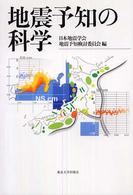- ホーム
- > 洋書
- > 英文書
- > Nature / Ecology
Full Description
A large number of scientific works are devoted to the study and modeling of accidental oil spills. However, there is no single approach to the description of processes and a generally accepted system of models. An additional fundamental difficulty is the impossibility of conducting full-fledged full-scale experimental studies, which makes it difficult to verify the adequacy and accuracy of oil spill models. Our book is devoted to the problems of experimental investigation and theoretical description of spills, as well as the practical removal of various petroleum products from the water surface and ice. It provides an overview of the most well-known theoretical models of the process of spreading oil stains on the water surface. Also, in the relevant sections, an original spreading model based on an energy approach is proposed and analyzed. The results of new experimental studies of the dynamics of the process for various hydrocarbons on water, including variations in its temperatureand salinity, are presented. In the following chapters, a theoretical description of oil spreading on the upper and lower surfaces of floating ice is proposed, modeling phenomena in the Arctic and subarctic zones of the world ocean. New experimental data on the spreading of petroleum products on the ice surface are presented. The final part provides a brief overview of the existing most used and promising methods for removing of hydrocarbons from the water surface. New original constructive solutions to this problem are proposed, the technical characteristics of which have received theoretical justification and experimental confirmation.
Contents
Introduction.- 1. General ecological problems of oil products spreading (with examples of catastrophic consequences).- 1.1 Environmental consequences of oil spills in the ocean.- 1.2 Assessment of economic damage resulting from accidental oil spills in offshore areas.- 1.3 Legal acts in the field of oil spill response.- 1.4 Monitoring of emergency oil spills and organization of measures to prevent and eliminate spills of oil and oil products.- 2. Overview of the main processes that determine the behavior of oil and oil products in the marine environment.- 3. General physical problems of modeling spreading processes.- 4. The most famous classical results of research on the problem.- 5. Theoretical model of oil products spreading over the water surface.- 5.1. Model of Axisymmetric Spreading of Hydrocarbons on the Water Surface.- 5.2. One-Dimensional Hydrocarbon Spreading Model.- 6. Laboratory experiments on the spreading of petroleum products.- 6.1. Axisymmetric spreading.- 6.2. One-dimensional spreading.- 6.3. Comparison with theoretical results.- 7. Theoretical model of oil product spreading in the subarctic and subantarctic zones.- 7.1. Spreading of hydrocarbons on the ice surface.- 7.2. Spreading of hydrocarbons under the ice surface.- 8. Modern model complexes for predicting the spread of oil spills in the sea.- 9. Determination of the content of oil products in water.- 10. Technologies and advanced methods for collecting oil spills.- 10.1 Review of existing methods and sorbents for the elimination of hydrocarbons from the water surface.- 10.2. Experimental studiesof the physical properties of various sorbents.- 10.3 Devices for collecting liquid hydrocarbons (oil, diesel fuel, etc.) from the surface of the water.- 10.4. Development of scientific foundations for new, efficient, low-cost technologies for cleaning the World Ocean from oil pollution.- Conclusions.- Literature.








